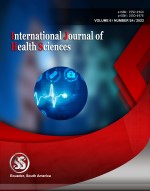Comparative evaluation of two different cold Sterilization techniques on carbide burs and diamond points
Keywords:
Cold, Sterilization, Burs, DiamondAbstract
Background: Infection control is a major issue in medicine and dentistry because of concern over communicable diseases transmitted in health care settings. The present study was conducted for comparatively evaluating various Cold Sterilization Techniques on Carbide Burs and Diamond Points. Materials & methods: The present study was conducted for comparatively evaluating various Cold Sterilization Techniques on Carbide Burs and Diamond Points. Two disinfectant solutions were used: 2% glutaraldehyde and 5.2% sodium hypochlorite. Carbide group formed Group A while diamond burs formed the group B. Collection of total 40 tooth samples was done .i.e. 20 samples in each group ; further both the study groups consisted of two subgroups each as per the type of disinfectant solution. The bacterial count was evaluated for both before and after disinfection. All the results were recorded and analysed by SPSS software. Results: Sodium hypochlorite sterilization technique was slightly better in comparison to Glutaraldehyde technique. Also carbide burs were associated with less microbial growth. Conclusion: Sodium hypochlorite sterilization technique and carbide burs were slightly better for clinical usage.
Downloads
References
Chung EM, Sung EC, Wu B, Caputo AA. Comparing cutting efficiencies of diamond burs using a high-speed electric handpiece. Gen Dent 2006;54:254-7.
Pilcher ES, Tietge JD, Draughn RA. Comparison of cutting rates among single-patient-use and multiple-patient-use diamond burs. J Prosthodont 2000;9:66-70.
Boldieri T, Bussaneli DG, Rodrigues JA, Cardoso K, Josgrilberg E, Cordiero R. Influence of sterilization process on cutting effectiveness and durability of ultrasonic tips. Braz Dent Sci 2015;18:10-16.
Fraunhofer Anthony Von, Siegel Sharon C. Using chemo-mechanically assisted diamond bur cutting for improved efficiency. J Am Dent Assoc. 2003;134:53.
Siegel Sharon C, Fraunhofer Anthony Von. The effect of handpiece spray patterns on cutting efficiency. J Am Dent Assoc. 2002;133:184
Siegel Sharon C, Fraunhofer Anthony Von. Irrigation rates and handpieces used in prosthodontic and operative dentistry: Results of a Survey of North American Dental School Teaching. J Prosthod. 2000;9:82–86.
Ohkuma K, Kazama M, Ogura H. The grinding efficiency by diamond points developed for yttria partially stabilized zirconia. Dent Mater J 2011;30:511-6.
Rodrigues SA Jr, Scherrer SS, Ferracane JL, Della Bona A. Microstructural characterization and fracture behavior of a microhybrid and a nanofill composite. Dent Mater 2008;24:1281-8.
Nakamura K, Katsuda Y, Ankyu S, Harada A, Tenkumo T, Kanno T, et al. Cutting efficiency of diamond burs operated with electric high-speed dental handpiece on zirconia. Eur J Oral Sci 2015;123:375-80.
Widyaningrum , I. ., Wibisono, N. ., & Kusumawati, A. H. . (2020). Effect of extraction method on antimicrobial activity against staphylococcus aureus of tapak liman (elephantopus scaber l.) leaves. International Journal of Health & Medical Sciences, 3(1), 105-110. https://doi.org/10.31295/ijhms.v3n1.181
Gonzaga CC, Falcão Spina DR, de Paiva Bertoli FM, Feres RL, Franco Fernandes AB, da Cunha LF. Cutting efficiency of different diamond burs after repeated cuts and sterilization cycles in autoclave. Indian J Dent Res 2019;30:915-9
Suryasa, I. W., Rodríguez-Gámez, M., & Koldoris, T. (2022). Post-pandemic health and its sustainability: Educational situation. International Journal of Health Sciences, 6(1), i-v. https://doi.org/10.53730/ijhs.v6n1.5949
Sharma S, Shankar R, Srinivas K. An Epidemiological Study on the Selection, Usage and Disposal of Dental Burs among the Dental Practioner's. J Clin Diagn Res. 2014;8(1):250-254.
Published
How to Cite
Issue
Section
Copyright (c) 2022 International journal of health sciences

This work is licensed under a Creative Commons Attribution-NonCommercial-NoDerivatives 4.0 International License.
Articles published in the International Journal of Health Sciences (IJHS) are available under Creative Commons Attribution Non-Commercial No Derivatives Licence (CC BY-NC-ND 4.0). Authors retain copyright in their work and grant IJHS right of first publication under CC BY-NC-ND 4.0. Users have the right to read, download, copy, distribute, print, search, or link to the full texts of articles in this journal, and to use them for any other lawful purpose.
Articles published in IJHS can be copied, communicated and shared in their published form for non-commercial purposes provided full attribution is given to the author and the journal. Authors are able to enter into separate, additional contractual arrangements for the non-exclusive distribution of the journal's published version of the work (e.g., post it to an institutional repository or publish it in a book), with an acknowledgment of its initial publication in this journal.
This copyright notice applies to articles published in IJHS volumes 4 onwards. Please read about the copyright notices for previous volumes under Journal History.
















